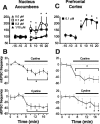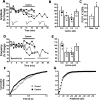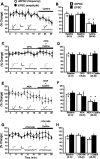Cystine/glutamate exchange regulates metabotropic glutamate receptor presynaptic inhibition of excitatory transmission and vulnerability to cocaine seeking
- PMID: 16000629
- PMCID: PMC1413952
- DOI: 10.1523/JNEUROSCI.1007-05.2005
Cystine/glutamate exchange regulates metabotropic glutamate receptor presynaptic inhibition of excitatory transmission and vulnerability to cocaine seeking
Abstract
Withdrawal from chronic cocaine reduces extracellular glutamate levels in the nucleus accumbens by decreasing cystine/glutamate exchange (xc-). Activating xc- with N-acetylcysteine restores extracellular glutamate and prevents cocaine-induced drug seeking. It was hypothesized that the activation of xc- prevents drug seeking by increasing glutamatergic tone on presynaptic group II metabotropic glutamate receptors (mGluR2/3) and thereby inhibiting excitatory transmission. In the first experiment, the capacity of glutamate derived from xc- to regulate excitatory transmission via mGluR2/3 was determined. Physiological levels of cystine (100-300 nm) were restored to acute tissue slices from the nucleus accumbens or prefrontal cortex. Cystine increased glutamate efflux and decreased miniature EPSC (mEPSC) and spontaneous EPSC (sEPSC) frequency as well as evoked EPSC amplitude. These effects of cystine were presynaptic, because there was no change in mEPSC or sEPSC amplitude, and an increase in the evoked EPSC paired-pulse facilitation ratio. The cystine-induced reduction in EPSCs was reversed by blocking either xc- or mGluR2/3. In the second experiment, blocking mGluR2/3 prevented the ability of N-acetylcystine to inhibit the reinstatement of drug seeking in rats trained to self-administer cocaine. These data demonstrate that nonsynaptic glutamate derived from xc- modulates synaptic glutamate release and thereby regulates cocaine-induced drug seeking.
Figures




Similar articles
-
Repeated exposure to cocaine alters the modulation of mesocorticolimbic glutamate transmission by medial prefrontal cortex Group II metabotropic glutamate receptors.J Neurochem. 2008 Oct;107(1):186-96. doi: 10.1111/j.1471-4159.2008.05593.x. Epub 2008 Jul 31. J Neurochem. 2008. PMID: 18673447 Free PMC article.
-
Modafinil attenuates reinstatement of cocaine seeking: role for cystine-glutamate exchange and metabotropic glutamate receptors.Addict Biol. 2014 Jan;19(1):49-60. doi: 10.1111/j.1369-1600.2012.00506.x. Epub 2012 Sep 27. Addict Biol. 2014. PMID: 23017017 Free PMC article.
-
Blunted cystine-glutamate antiporter function in the nucleus accumbens promotes cocaine-induced drug seeking.Neuroscience. 2008 Aug 13;155(2):530-7. doi: 10.1016/j.neuroscience.2008.06.010. Epub 2008 Jun 10. Neuroscience. 2008. PMID: 18601982 Free PMC article.
-
Glutamate: the new frontier in pharmacotherapy for cocaine addiction.CNS Neurol Disord Drug Targets. 2008 Nov;7(5):482-91. doi: 10.2174/187152708786927868. CNS Neurol Disord Drug Targets. 2008. PMID: 19128205 Review.
-
Cocaine use disorder: A look at metabotropic glutamate receptors and glutamate transporters.Pharmacol Ther. 2021 May;221:107797. doi: 10.1016/j.pharmthera.2020.107797. Epub 2021 Jan 9. Pharmacol Ther. 2021. PMID: 33359590 Review.
Cited by
-
Gq-DREADD Selectively Initiates Glial Glutamate Release and Inhibits Cue-induced Cocaine Seeking.Biol Psychiatry. 2015 Oct 1;78(7):441-51. doi: 10.1016/j.biopsych.2015.02.016. Epub 2015 Feb 24. Biol Psychiatry. 2015. PMID: 25861696 Free PMC article.
-
Pharmacotherapeutics directed at deficiencies associated with cocaine dependence: focus on dopamine, norepinephrine and glutamate.Pharmacol Ther. 2012 May;134(2):260-77. doi: 10.1016/j.pharmthera.2012.01.010. Epub 2012 Jan 31. Pharmacol Ther. 2012. PMID: 22327234 Free PMC article. Review.
-
Cocaine-induced adaptations in metabotropic inhibitory signaling in the mesocorticolimbic system.Rev Neurosci. 2012;23(4):325-51. doi: 10.1515/revneuro-2012-0045. Rev Neurosci. 2012. PMID: 22944653 Free PMC article. Review.
-
Induction of cystine/glutamate transporter in bacterial lipopolysaccharide induced endotoxemia in mice.J Inflamm (Lond). 2007 Sep 26;4:20. doi: 10.1186/1476-9255-4-20. J Inflamm (Lond). 2007. PMID: 17897437 Free PMC article.
-
Circadian entrainment by food and drugs of abuse.Behav Processes. 2019 Aug;165:23-28. doi: 10.1016/j.beproc.2019.05.017. Epub 2019 May 24. Behav Processes. 2019. PMID: 31132444 Free PMC article. Review.
References
-
- Alagarsamy S, Sorensen SD, Conn PJ (2001) Coordinate regulation of metabotropic glutamate receptors. Curr Opin Neurobiol 11: 357-362. - PubMed
-
- Baker DA, McFarland K, Lake RW, Shen H, Tang XC, Toda S, Kalivas PW (2003) Neuroadaptations in cystine-glutamate exchange underlie cocaine relapse. Nat Neurosci 6: 743-749. - PubMed
Publication types
MeSH terms
Substances
Grants and funding
LinkOut - more resources
Full Text Sources
Other Literature Sources
Medical
